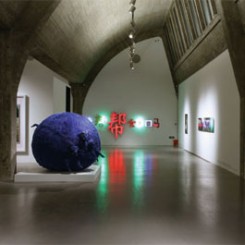Xiao Yu’s extraordinary installation, “Wu” (2000), provided another example, for although this work sat right out in the open as it were, it also suffered for this placement in the display: there is something about the formal arrangement of the gallery space, its whiteness, clinical contours and hushed atmosphere, that contrived to make “Wu” appear closer to an attraction in a children’s petting zoo rather than the insightful exploration of manmade / mutated / gnomically-altered life forms that pass for domestic animals today. Under these circumstances, “Wu” also failed to induce the dramatic viewer response that was indeed elicited upon its debut in 2000 as part of the exhibition “Harm / Hurt,” a seminal exhibition of its moment when issues of cloning and moral-ethical attitudes towards life / life forms were subject to fierce debate. Naturally the aura of “Harm / Hurt,” coupled with its considered siting in an old theatre in a hutong in Beijing, contributed to the shock and awe in which it was received, none of which was addressed for any of these “great performances.”
Moving through the exhibition, despite there being an extraordinary range of works, those most relevant to the history and development of performance art in China suffered from the lack of context provided, specifically of the complex web of relationships and circumstances that inspired them. This was manifest in various ways, foremost in the neutering affect that this pristine space had upon many of the works in the show, and in particular those associated with real acts of performance: He Yunchang’s “Keeping Promise” was originally a work of gruelling endurance. The artist had himself incarcerated in a concrete block in a gallery for 24 hours, alone in total darkness with no escape. Here, the performance was rendered in a single photograph of the artist as he emerged half suffocated and exhausted in front of the audience. A dramatic image but one that provided little sense of the extraordinary physical and, one imagines, psychological experience that preceded it.
